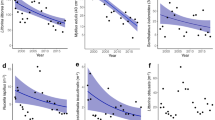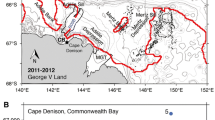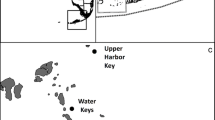Abstract
The condition of seagrass habitat and the marine environment on the Bermuda Platform, a mid-oceanic shallow water habitat in the northwest Atlantic, has been monitored since 2006. The overall oceanic climate of the Platform is subtropical; the Platform supports communities of tropical marine seagrasses, including Thalassia testudinum, Syringodium filiforme, Halodule sp., and Halophila decipiens. At the beginning of the study, the general condition of seagrass beds at 17 permanent offshore and nearshore sites indicated that 14 were healthy, complex, and thriving communities, and three represented offshore beds, which had declined precipitously prior to the initiation of study. Over the period of the study, seagrass beds declined at all 17 sites; three beds disappeared, and there was no recovery at the sites known to have declined prior to 2006. Over the same period, there was no apparent negative change in the water quality overlying the seagrass beds. Assessments of elemental content, stable isotopic composition, and leaf morphology indicated that grazing by the green turtle (Chelonia mydas) is driving the decline of the seagrasses of Bermuda. Given the feeding behavior of these turtles on the Bermuda Platform, human intervention may be required to mitigate the decline of seagrass in Bermuda.




Similar content being viewed by others
References
Abal, E.G., N. Loneragan, P. Bowen, C.J. Perry, J.W. Udy, and W.C. Dennison. 1994. Physiological and morphological responses of the seagrass Zostera capricorni Ascher. to light intensity. Journal of Experimental Marine Biology and Ecology 178 (1): 113–129.
Ammerman, J.W., R.R. Hood, D.A. Case, and J.B. Cotner. 2003. Phosphorus deficiency in the Atlantic: an emerging paradigm in oceanography. Eos 84 (18): 165–170.
Armitage, A.R., and J.W. Fourqurean. 2006. The short-term influence of herbivory near patch reefs varies between seagrass species. Journal of Experimental Marine Biology and Ecology 339 (1): 65–74.
Atkinson, M.J., and S.V. Smith. 1983. C:N:P ratios of benthic marine plants. Limnology and Oceanography 28 (3): 568–574.
Austin, A.N., J.P. Hansen, S. Donadi, and J.S. Eklof. 2017. Relationships between aquatic vegetation and water turbidity: a field survey across seasons and spatial scales. PLoS One 12 (8): 20. https://doi.org/10.1371/journal.pone.0181419.
Baker, D.M., T.J.T. Murdoch, I. Conti-Jerpe, and M. Fogel. 2017. Investigating Bermuda’s pollution history through stable isotope analyses of modern and museum-held gorgonian corals. Marine Pollution Bulletin 114 (1): 169–175. https://doi.org/10.1016/j.marpolbul.2016.08.069.
Beck, M.W., K.L. Heck, K.W. Able, D.L. Childers, D.B. Eggleston, B.M. Gillanders, B. Halpern, et al. 2001. The identification, conservation, and management of estuarine and marine nurseries for fish and invertebrates. BioScience 51 (8): 633–641. https://doi.org/10.1641/0006-3568(2001)051[0633:ticamo]2.0.co;2.
Bjorndal, K.A. 1997. Foraging ecology and nutrition of sea turtles. In The biology of sea turtles, ed. P.L. Lutz and J.A. Musick, 199–231. Boca Raton: CRC Press.
Bjorndal, K.A., A.B. Bolten, and M.Y. Chaloupka. 2000. Green turtle somatic growth model: evidence for density dependence. Ecological Applications 10 (1): 269–282. https://doi.org/10.2307/2641001.
Blandon, A., and P.S.E. zu Ermgassen. 2014. Quantitative estimate of commercial fish enhancement by seagrass habitat in southern Australia. Estuarine Coastal and Shelf Science 141: 1–8. https://doi.org/10.1016/j.ecss.2014.10.009.
Burgett, C.M., D.A. Burkholder, K.A. Coates, V.L. Fourqurean, W.J. Kenworthy, S.A. Manuel, M.E. Outerbridge, and J.W. Fourqurean. 2018. Ontogenetic diet shifts of green sea turtles (Chelonia mydas) in a mid-ocean developmental habitat. Marine Biology 16: 33. https://doi.org/10.1007/s00227-018-3290-6.
Burkholder, D.A., M.R. Heithaus, J.A. Thomson, and J.W. Fourqurean. 2011. Diversity in trophic interactions of green sea turtles (Chelonia mydas) on a relatively pristine coastal seagrass foraging ground. Marine Ecology Progress Series 439: 277–293. https://doi.org/10.3354/meps09313.
Burkholder, D.A., M.R. Heithaus, and J.W. Fourqurean. 2012. Feeding preferences of herbivores in a relatively pristine subtropical seagrass ecosystem. Marine and Freshwater Research 63 (11): 1051–1058. https://doi.org/10.1071/mf12029.
Campbell, J.E., and J.W. Fourqurean. 2009. Interspecific variation in the elemental and stable isotopic content of seagrasses in South Florida. Marine Ecology Progress Series 387: 109–123.
Cardona, L., A. Aguilar, and L. Pazos. 2009. Delayed ontogenic dietary shift and high levels of omnivory in green turtles (Chelonia mydas) from the NW coast of Africa. Marine Biology 156 (7): 1487–1495. https://doi.org/10.1007/s00227-009-1188-z.
Christianen, M.J.A., P.M.J. Herman, T.J. Bouma, L.P.M. Lamers, M.M. van Katwijk, T. van der Heide, P.J. Mumby, B.R. Silliman, S.L. Engelhard, M. van de Kerk, W. Kiswara, and J. van de Koppel. 2014. Habitat collapse due to overgrazing threatens turtle conservation in marine protected areas. Proceedings of the Royal Society B-Biological Sciences 281 (1777): 20132890. https://doi.org/10.1098/rspb.2013.2890.
Coates, K.A., J.W. Fourqurean, W.J. Kenworthy, A. Logan, S.A. Manuel, and S.R. Smith. 2013. Introduction to Bermuda geology, oceanography and climate. In Coral reefs of the world, ed. C. Sheppard . Dordrecht: Springer.336pp
Cooper, L.W., and M.J. DeNiro. 1989. Stable carbon isotope variability in the seagrass Posidonia oceanica: evidence for light intensity effects. Marine Ecology Progress Series 50: 225–229.
Costanza, R., R. de Groot, P. Sutton, S. van der Ploeg, S.J. Anderson, I. Kubiszewski, S. Farber, and R.K. Turner. 2014. Changes in the global value of ecosystem services. Global Environmental Change-Human and Policy Dimensions 26: 152–158. https://doi.org/10.1016/j.gloenvcha.2014.04.002.
de Groot, R., L. Brander, S. van der Ploeg, R. Costanza, F. Bernard, L. Braat, M. Christie, N. Crossman, A. Ghermandi, L. Hein, S. Hussain, P. Kumar, A. McVittie, R. Portela, L.C. Rodriguez, P. ten Brink, and P. van Beukering. 2012. Global estimates of the value of ecosystems and their services in monetary units. Ecosystem Services 1 (1): 50–61. https://doi.org/10.1016/j.ecoser.2012.07.005.
Duarte, C.M. 1990. Seagrass nutrient content. Marine Ecology Progress Series 67: 201–207.
Duarte, C.M. 1995. Submerged aquatic vegetation in relation to different nutrient regimes. Ophelia 41 (1): 87–112.
Duarte, C.M., N. Marba, E. Gacia, J.W. Fourqurean, J. Beggins, C. Barron, and E.T. Apostolaki. 2010. Seagrass community metabolism: assessing the carbon sink capacity of seagrass meadows. Global Biogeochemical Cycles 24 (4): GB4032. https://doi.org/10.1029/2010GB003793.
Fourqurean, J.W., and L.M. Rutten. 2003. Competing goals of spatial and temporal resolution: monitoring seagrass communities on a regional scale. In Monitoring ecosystem initiatives: interdisciplinary approaches for evaluating ecoregional initiatives, ed. D.E. Busch and J.C. Trexler, 257–288. Washington, D. C: Island Press.
Fourqurean, J.W., J.C. Zieman, and G.V.N. Powell. 1992. Relationships between porewater nutrients and seagrasses in a subtropical carbonate environment. Marine Biology 114: 57–65.
Fourqurean, J.W., G.V.N. Powell, W.J. Kenworthy, and J.C. Zieman. 1995. The effects of long-term manipulation of nutrient supply on competition between the seagrasses Thalassia testudinum and Halodule wrightii in Florida Bay. Oikos 72 (3): 349–358.
Fourqurean, J.W., A.W. Willsie, C.D. Rose, and L.M. Rutten. 2001. Spatial and temporal pattern in seagrass community composition and productivity in South Florida. Marine Biology 138 (2): 341–354.
Fourqurean, J.W., S.P. Escorcia, W.T. Anderson, and J.C. Zieman. 2005. Spatial and seasonal variability in elemental content, δ13C, and δ15N of Thalassia testudinum from South Florida and its implications for ecosystem studies. Estuaries 28 (3): 447–461.
Fourqurean, J.W., N. Marbà, C.M. Duarte, E. Diaz-Almela, and S. Ruiz-Halpern. 2007. Spatial and temporal variation in the elemental and stable isotopic content of the seagrasses Posidonia oceanica and Cymodocea nodosa from the Illes Balears, Spain. Marine Biology 151 (1): 219–232.
Fourqurean, J.W., S. Manuel, K.A. Coates, W.J. Kenworthy, and S.R. Smith. 2010. Effects of excluding sea turtle herbivores from a seagrass bed: overgrazing may have led to loss of seagrass meadows in Bermuda. Marine Ecology Progress Series 419: 223–232.
Fourqurean, J.W., C.M. Duarte, H. Kennedy, N. Marba, M. Holmer, M.A. Mateo, E.T. Apostolaki, et al. 2012. Seagrass ecosystems as a globally significant carbon stock. Nature Geoscience 5 (7): 505–509. https://doi.org/10.1038/ngeo1477.
Fourqurean, J.W., S.A. Manuel, K.A. Coates, W.J. Kenworthy, and J.N. Boyer. 2015. Water quality, isoscapes and stoichioscapes of seagrasses indicate general P limitation and unique N cycling in shallow water benthos of Bermuda. Biogeosciences 12 (20): 6235–6249. https://doi.org/10.5194/bg-12-6235-2015.
Grice, A.M., N.R. Loneragan, and W.C. Dennison. 1996. Light intensity and the interactions between physiology, morphology and stable isotope ratios in five species of seagrass. Journal of Experimental Marine Biology and Ecology 195 (1): 91–110.
Hatase, H., K. Sato, M. Yamaguchi, K. Takahashi, and K. Tsukamoto. 2006. Individual variation in feeding habitat use by adult female green sea turtles (Chelonia mydas): are they obligately neritic herbivores? Oecologia 149 (1): 52–64. https://doi.org/10.1007/s00442-006-0431-2.
Heithaus, M.R., T. Alcoverro, R. Arthur, D.A. Burkholder, K.A. Coates, M.J.A. Christianen, N. Kelkar, et al. 2014. Seagrasses in the age of sea turtle conservation and shark overfishing. Frontiers in Marine Science 1: 28.
Hemminga, M.A., and C.M. Duarte. 2000. Seagrass ecology. Cambridge: Cambridge University Press.
Hernandez, A.L.M., and B.I. van Tussenbroek. 2014. Patch dynamics and species shifts in seagrass communities under moderate and high grazing pressure by green sea turtles. Marine Ecology Progress Series 517: 143–157. https://doi.org/10.3354/meps11068.
Holzer, K.K., and K.J. McGlathery. 2016. Cultivation grazing response in seagrass may depend on phosphorus availability. Marine Biology 163 (4): 11. https://doi.org/10.1007/s00227-016-2855-5.
Howell, L.N., K.J. Reich, D.J. Shaver, A.M. Landry, and C.C. Gorga. 2016. Ontogenetic shifts in diet and habitat of juvenile green sea turtles in the northwestern Gulf of Mexico. Marine Ecology Progress Series 559: 217–229. https://doi.org/10.3354/meps11897.
Hu, X.P., D.J. Burdige, and R.C. Zimmerman. 2012. delta C-13 is a signature of light availability and photosynthesis in seagrasses. Limnology and Oceanography 57 (2): 441–448.
Jones, R., R. Parsons, E. Watkinson, and D. Kendell. 2011. Sewage contamination of a densely populated coral ‘atoll’ (Bermuda). Environmental Monitoring and Assessment 179 (1–4): 309–324. https://doi.org/10.1007/s10661-010-1738-3.
Kelkar, N., R. Arthur, M. Marba, and T. Alcoverro. 2013. Greener pastures? High-density feeding aggregations of green turtles precipitate species shifts in seagrass meadows. Journal of Ecology 101 (5): 1158–1168. https://doi.org/10.1111/1365-2745.12122.
Lacey, E.A., L. Collado-Vides, and J. Fourqurean. 2014. Morphological and physiological responses of seagrass (Alismatales) to grazers (Testudines: Cheloniidae) and the role of these responses as patch abandonment cues. Revista Biologia Tropical 62 (4): 1535–1548.
Lal, A., R. Arthur, N. Marbà, A.W.T. Lill, and T. Alcoverro. 2010. Implications of conserving an ecosystem modifier: increasing green turtle (Chelonia mydas) densities substantially alters seagrass meadows. Biological Conservation 143 (11): 2730–2738.
Lamb, J.B., Jajm van de Water, D.G. Bourne, C. Altier, M.Y. Hein, E.A. Fiorenza, N. Abu, J. Jompa, and C.D. Harvell. 2017. Seagrass ecosystems reduce exposure to bacterial pathogens of humans, fishes, and invertebrates. Science 355 (6326): 731–73+. https://doi.org/10.1126/science.aal1956.
Lapointe, B.E., and J. O'Connell. 1989. Nutrient-enhanced growth of Cladophora prolifera in Harrington Sound, Bermuda: eutrophication of a confined, phosphorus-limited marine ecosystem. Estuarine, Coastal and Shelf Science 28 (4): 347–360.
Lomas, M.W., A. Swain, R. Shelton, and J.A. Ammerman. 2004. Taxonomic variability of phosphorus stress in Sargasso Sea phytoplankton. Limnology and Oceanography 49: 2303–2310.
Manuel, S.A., K.A. Coates, W.J. Kenworthy, and J.W. Fourqurean. 2013. Tropical species at the northern limit of their range: composition and distribution in Bermuda’s benthic habitats in relation to depth and light availability. Marine Environmental Research 89: 63–75. https://doi.org/10.1016/j.marenvres.2013.05.003.
Mariani, S., and T. Alcoverro. 1999. A multiple-choice feeding-preference experiment utilising seagrasses with a natural population of herbivorous fish. Marine Ecology Progress Series 189: 295–299.
McClelland, J.W., I. Valiela, and R.H. Michemer. 1997. Nitrogen-stable isotope signatures in estuarine food webs: a record of increasing urbanization in coastal watersheds. Limnology and Oceanography 42: 930–937.
McGlathery, K.J., R.W. Howarth, and R. Marino. 1992. Nutrient limitation of the macroalga, Penicillus capitatus, associated with subtropical seagrass meadows in Bermuda. Estuaries 15 (1): 18–25.
McMahon, K., C. Collier, and P.S. Lavery. 2013. Identifying robust bioindicators of light stress in seagrasses: a meta-analysis. Ecological Indicators 30: 7–15. https://doi.org/10.1016/j.ecolind.2013.01.030.
Meylan, P.A., A.B. Meylan, and J.A. Gray. 2011. The ecology and migrations of sea turtles 8. Tests of the developmental habitat hypothesis. Bulletin of the American Museum of Natural History 357: 1–70.
Moore, K.A. 2004. Influence of seagrasses on water quality in shallow regions of the lower Chesapeake Bay. Journal of Coastal Research 10045: 162–178.
Moran, K.L., and K.A. Bjorndal. 2005. Simulated green turtle grazing affects structure and productivity of seagrass pastures. Marine Ecology Progress Series 305: 235–247.
Moran, K.L., and K.A. Bjorndal. 2007. Simulated green turtle grazing affects nutrient composition of the seagrass Thalassia testudinum. Marine Biology 150 (6): 1083–1092.
Murdoch, T.J.T., A.F. Glasspool, M. Outerbridge, J. Ward, S. Manuel, J. Gray, A. Nash, K.A. Coates, J. Pitt, J.W. Fourqurean, P.A. Barnes, M. Vierros, K. Holzer, and S.R. Smith. 2007. Large-scale decline in offshore seagrass meadows in Bermuda. Marine Ecology Progress Series 339: 123–130.
Mutchler, T., and D.K. Hoffman. 2017. Response of seagrass (Thalassia testudinum) metrics to short-term nutrient enrichment and grazing manipulations. Journal of Experimental Marine Biology and Ecology 486: 105–113. https://doi.org/10.1016/j.jembe.2016.09.015.
Norlund, L.M., R.K.F. Unsworth, M. Gullström, and L. Cullen-Unsworth. 2018. Global significance of seagrass fishery activity. Fish and Fisheries 19 (3): 399–412.
Orth, R.J., T.J.B. Carruthers, W.C. Dennison, C.M. Duarte, J.W. Fourqurean, K.L. Heck, A.R. Hughes, et al. 2006. A global crisis for seagrass ecosystems. BioScience 56 (12): 987–996.
Powell, G.V.N., W.J. Kenworthy, and J.W. Fourqurean. 1989. Experimental evidence for nutrient limitation of seagrass growth in a tropical estuary with restricted circulation. Bulletin of Marine Science 44 (1): 324–340.
Powell, G.V.N., J.W. Fourqurean, W.J. Kenworthy, and J.C. Zieman. 1991. Bird colonies cause seagrass enrichment in a subtropical estuary: observational and experimental evidence. Estuarine, Coastal and Shelf Science 32 (6): 567–579.
Preen, A. 1995. Diet of dugongs - are they omnivores. Journal of Mammalogy 76 (1): 163–171. https://doi.org/10.2307/1382325.
Salihiglu, B., V. Garçon, A. Oschilies, and M.W. Lomas. 2008. Influence of nutrient utilization and remineralization stoichiometry on phytoplankton species and carbon export: a modeling study at BATS. Deep Sea Research Part 1: Oceanographic Research Papers 55 (1): 73–107.
Santos, R.G., A.S. Martins, M.B. Batista, and P.A. Horta. 2015. Regional and local factors determining green turtle Chelonia mydas foraging relationships with the environment. Marine Ecology Progress Series 529: 265–277. https://doi.org/10.3354/meps11276.
Schneider, C.W., and C.T. Flook. 2017. Could marine animal conservation laws be responsible for the decline or extirpation of macroalgal populations in Bermuda over the past century? Botanica Marina 60 (6): 591–602. https://doi.org/10.1515/bot-2017-0057.
Shimada, T., S. Aoki, K. Kameda, J. Hazel, K. Reich, and N. Kamezaki. 2014. Site fidelity, ontogenetic shift and diet composition of green turtles Chelonia mydas in Japan inferred from stable isotope analysis. Endangered Species Research 25 (2): 151–164. https://doi.org/10.3354/esr00616.
Short, F.T., and S. Wyllie-Echeverria. 1996. Natural and human-induced disturbance of seagrasses. Environmental Conservation 23 (1): 17–27.
Teague, R., F. Provenza, U. Kreuter, T. Steffens, and M. Barnes. 2013. Multi-paddock grazing on rangelands: why the perceptual dichotomy between research results and rancher experience? Journal of Environmental Management 128: 699–717. https://doi.org/10.1016/j.jenvman.2013.05.064.
Thayer, G.W., K.A. Bjorndal, J.C. Ogden, S.L. Williams, and J.C. Zieman. 1984. Role of larger herbivores in seagrass communities. Estuaries 7 (4A): 351–376.
van Tussenbroek, B.I., J. Cortes, R. Collin, A.C. Fonseca, P.M.H. Gayle, H.M. Guzman, G.E. Jacome, et al. 2014. Caribbean-wide, long-term study of seagrass beds reveals local variations, shifts in community structure and occasional collapse. PLoS One 9 (3): e90600. https://doi.org/10.1371/journal.pone.0090600.
Vincent, A.C.J., S.J. Foster, and H.J. Koldewey. 2011. Conservation and management of seahorses and other Syngnathidae. Journal of Fish Biology 78 (6): 1681–1724. https://doi.org/10.1111/j.1095-8649.2011.03003.x.
Waycott, M., C.M. Duarte, T.J.B. Carruthers, R.J. Orth, W.C. Dennison, S. Olyarnik, A. Calladine, J.W. Fourqurean, K.L. Heck, A.R. Hughes, G.A. Kendrick, W.J. Kenworthy, F.T. Short, and S.L. Williams. 2009. Accelerating loss of seagrasses across the globe threatens coastal ecosystems. Proceedings of the National Academy of Sciences of the United States of America 106 (3): 12377–12381.
Wiginton, J.R., and C. McMillan. 1979. Chlorophyll composition under controlled light conditions as related to the distribution of seagrasses in Texas and the U.S Virgin Islands. Aquatic Botany 6: 171–184.
Williams, S.L. 1988. Thalassia testudinum productivity and grazing by green turtles in a highly disturbed seagrass bed. Marine Biology 98 (3): 447–455.
Zieman, J.C., R.L. Iverson, and J.C. Ogden. 1984. Herbivory effects on Thalassia testudinum leaf growth and nitrogen content. Marine Ecology Progress Series 15: 151–158.
Acknowledgments
Water quality data were collected and analyzed by J. N. Boyer and H. O. Briceño in the Southeast Environmental Research Program at Florida International University under contract from The Bermuda Government. We thank Anson Nash, Jan Locke, Katie Dilke, Kascia White, Sarah Gosling, and Sara Wilson for many hours of help in the field and laboratory.
Funding
The Department of Conservation Services (now the Department of Environment and Natural Resources) of the Government of Bermuda provided logistics and financial support for this work. Support for WJK was provided by the Center for Coastal Fisheries and Habitat Research, one of the National Centers for Coastal Ocean Science in the National Ocean Service within the US National Oceanic and Atmospheric Administration; financial support for KAC and Katie Dilke was provided by Mr. Bruce Dilke. This is contribution #137 from the Center for Coastal Oceans Research in the Institute of Water and Environment at Florida International University and contribution #277 of the Bermuda Biodiversity Project series, Bermuda Aquarium, Museum and Zoo, Bermuda Department of Environment and Natural Resources.
Author information
Authors and Affiliations
Corresponding author
Additional information
Communicated by Masahiro Nakaoka
Electronic supplementary material
ESM 1
Detailed description of water quality methods: ESM_1.pdf (PDF 78 kb)
ESM 2
Time series plots of water quality data from all 17 permanent monitoring stations: ESM_2.pdf (PDF 1150 kb)
ESM 3
Time series plots of measured seagrass metrics from all 17 permanent monitoring stations: ESM_3.pdf (PDF 988 kb)
Rights and permissions
About this article
Cite this article
Fourqurean, J.W., Manuel, S.A., Coates, K.A. et al. Decadal Monitoring in Bermuda Shows a Widespread Loss of Seagrasses Attributable to Overgrazing by the Green Sea Turtle Chelonia mydas. Estuaries and Coasts 42, 1524–1540 (2019). https://doi.org/10.1007/s12237-019-00587-1
Received:
Revised:
Accepted:
Published:
Issue Date:
DOI: https://doi.org/10.1007/s12237-019-00587-1




